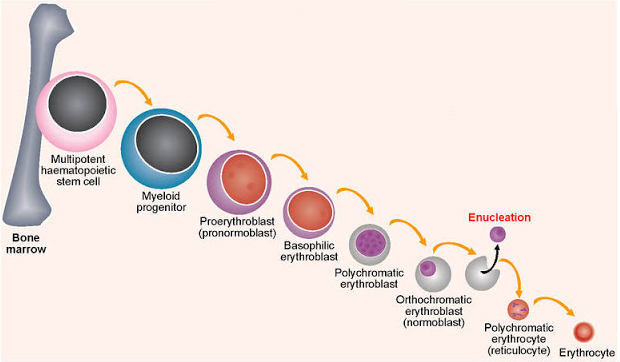Question #5f9ca
1 Answer
Red blood cells have lost their nucleus prior to reaching the circulation. Several mechanisms have been proposed.
Explanation:
This is quite a long answer, because a lot is still unknown. I've tried to make it as complete and understandable as possible.
Mature erythrocytes develop from stem cells in bone marrow in several steps as shown in the image below. A proerythroblast with a nucleus develops to a reticulocyte without nucleus in about 7 days. A reticulocyte is formed after enucleation ('loss' of the nucleus) in the step before. Reticulocytes can enter the blood stream and mature there in 1 to 2 day into erythrocytes. So a red blood cell as we know it already lost its nucleus.

Changes in the early maturation process involve condensation of chromosomes and suppression of transcription. Also the scaffolds in the cell (microfilaments) are partially degraded, making the cell more flexible.
Apoptosis
One theory about how enucleation is carried out includes apoptosis (programmed cell death). This is supported by findings that part of the genetic material is degraded and that part of the nuclear material leaks into the cytoplasm prior to enucleation. Although it might be a part of the mechanism, studies show that enucleation can occur without apoptosis.
Asymmetric cytokinesis
Another theory is that enucleation is a form of asymmetric cytokinesis: the contents of the cell are unequally divided between the two daughter cells. Since microfilaments are partly broken down, the nucleus can move to one side of the cell (polarization). Two cells are created:
- reticulocyte: cell with most of the cytoplasm but without the nucleus; destined to become a mature erythrocyte
- pyrenocyte: cell with the nucleus and a small amount of cytoplasm; destined to be degraded.
The fact that pyrenocytes do contain some plasma and have a cellular membrane shows that the nucleus isn’t simply expelled, but neatly packaged.
Involvement of macrophages
Macrophages appear to be involved in the process of nuclear extrusion and probably degrade the pyrenocytes. Studies showed that pyrenocytes have different membrane proteins/ phospholipids than reticulocytes, which might explain why macrophages selectively bind to the pyreneocytes.
As with the apoptosis theory, it has been shown that enucleation can also occur without macrophages, meaning there are other processes involved.
Outlook
Much research is spent now on finding the factors that trigger enucleation and to clarify the exact mechanims. Being able to understand this process is important because it would give researchers the tools to make blood for transfusion from stem cells. In addition, enucleation has been proposed as a good way to kill cancer cells.

